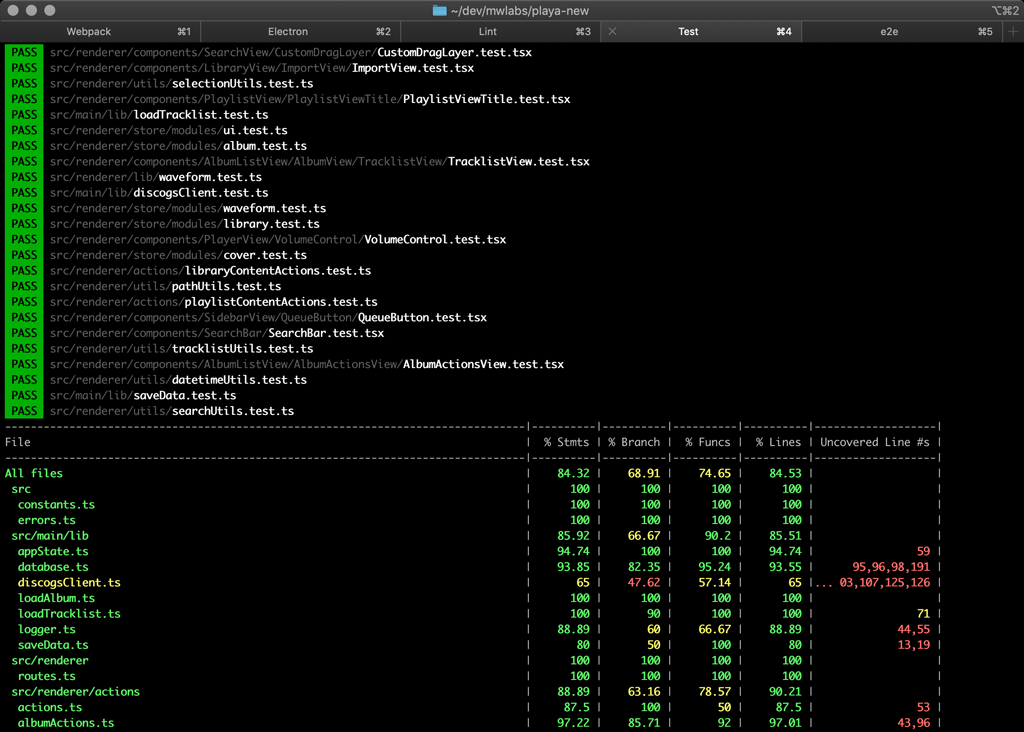In this post I give an overview of the app infrastructure and the tasks I run in the development environment, from watching to testing to the build step.
# Typescript
The configuration is fairly standard, exception made for some modules:
// tsconfig.json
{
"compilerOptions": {
"jsx": "react",
"module": "ESNext",
"moduleResolution": "node",
"resolveJsonModule": true,
"allowSyntheticDefaultImports": true,
"noImplicitAny": true,
"noImplicitThis": true,
"sourceMap": true,
"esModuleInterop": true,
"target": "es2017",
"types": ["node", "lodash", "express", "electron", "electron-settings", "pouchdb", "jest"]
},
"include": [
"typings.d.ts",
"src/**/*.ts",
"src/**/*.tsx"
],
"exclude": ["node_modules"]
}
// typings.d.ts
declare module 'pouchdb-quick-search';
declare module 'disconnect';
declare module 'sha1';
declare module 'browser-id3-writer';# Electron
In a traditional application, the backend process runs on a server, while the frontend runs on the remote clients. An Electron app has two heads: a main process similar to the former that interacts with the operation system, and a renderer process that handles the browser code and takes care of the user interaction.
Even though one could use all node modules from the renderer as well, it is good practice to minimise such interaction and to rely as much as possible on the ipc (inter process communication) module.
The fact that the code for the two processes share the same physical location can be a source of confusion:
src
main
main.ts
renderer
index.html
index.tsA peek at the webpack configuration will fugue that:
const outputFolder = '/_pack';
const mainConfig = {
entry: './src/main/main.ts',
target: 'electron-main',
output: {
filename: 'main.bundle.js',
path: __dirname + outputFolder
},
...
}
const rendererConfig = {
entry: './src/renderer/index.tsx',
target: 'electron-renderer',
output: {
filename: 'renderer.bundle.js',
path: __dirname + outputFolder
},
...
}
module.exports = {
mainConfig,
rendererConfig
};Two separate bundles are generated - one used by the main Electron process, and one inside the Chromium instance. The app infact starts with:
$ electron ./_pack/main.bundle.jsThis loads the main.ts file, that requests index.html (inside whom webpack injected a reference to renderer.bundle.js):
mainWindow.loadURL(
url.format({
pathname: Path.join(__dirname, './index.html'),
protocol: 'file:',
slashes: true,
})
);All code is watched in a separated terminal tab via $ webpack --watch --config ./webpack.dev.js.
# Lint
Nothing too fancy here as well. Do not forget to use react-hooks/rules-of-hooks!
//.eslintrc.js
module.exports = {
root: true,
parser: '@typescript-eslint/parser',
plugins: [
'@typescript-eslint',
'react',
'react-hooks'
],
rules: {
'react/jsx-uses-react': 'error',
'react/jsx-uses-vars': 'error',
'react-hooks/rules-of-hooks': 'error'
},
extends: [
'eslint:recommended',
'plugin:@typescript-eslint/eslint-recommended',
'plugin:@typescript-eslint/recommended',
],
};I setup a lint command in package.json that runs $ yarn eslint ./src --ext .js,.jsx,.ts,.tsx of course.
# Test
I run unit/integration and e2e tests both via jest, via following commands:
- test ->
$ jest --config jest.config.js; - test:e2e ->
$ jest --runInBand --config jest.config.e2e.js.
More about the specific strategies in the test and e2e tests posts respectively.
# Build
At the moment I am building the app just for OS X, because it is the only platform available to me. Contributions for Linux/Win are mostly welcome of course.
The pack command first bundles the js code for production (webpack --config ./webpack.prod.js), then uses electron-builder.
# Terminal setup
I find very useful to have a fixed terminal tab setup when dealing with repeated and ongoing tasks. In this case I need to monitor:
- the webpack logs (watching);
- the electron logs (watching);
- lint output;
- test output;
- e2d test output.
I renamed the tab accordingly and saved them as a session:

It is enough to ⌘+1-5, then ↑ + Enter to rerun the command if needed.
It may look trivial, but not to have to think much to which tab I have to switch saves time!